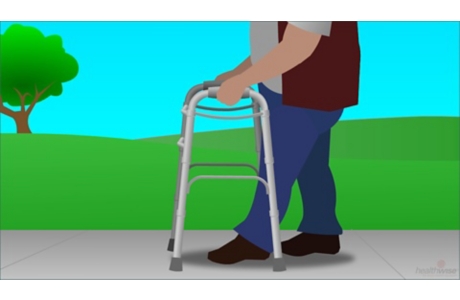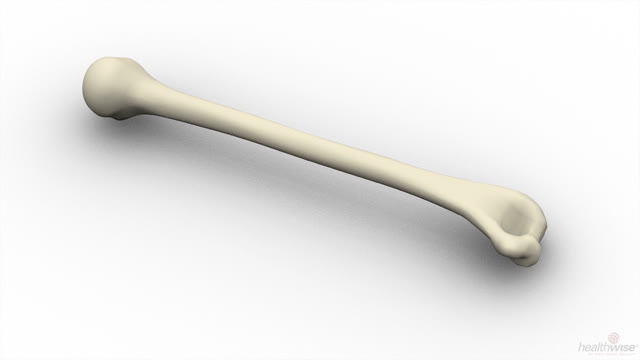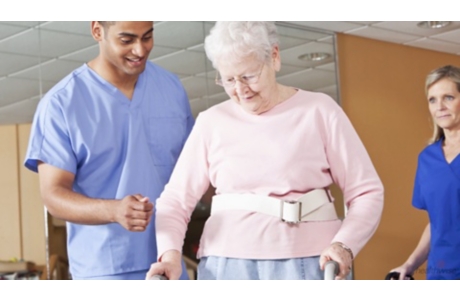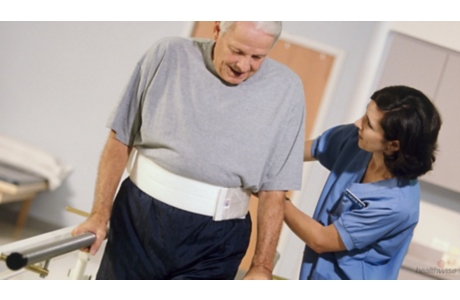Hip Fracture
Topic Overview

What is a hip fracture?
A hip fracture is more than a broken bone. If you are older, breaking your hip can mean a major change in your life. You will probably need surgery, and it can take as long as a year to recover. But activity and physical therapy can help you get your strength and mobility back.
Most people break their hip near the upper part of the thighbone (femur). It usually happens near where the thighbone fits into the hip joint.
What causes hip fractures?
Most hip fractures happen to people who are 65 or older, and they are usually caused by falls. As you get older, your bones naturally lose some strength and are more likely to break, even from a minor fall. Children and young adults are more likely to break a hip because of a bike or car accident or a sports injury.
Other things that increase your risk of breaking your hip include:
- Being female.
- Your family history—being thin or tall or having family members who had fractures later in life.
- Not getting enough calcium and vitamin D, which you need for strong bones.
- Not being active. Weight-bearing exercise, such as walking, helps keep bones strong.
- Smoking.
- Medical conditions that cause dizziness or problems with balance, or conditions such as arthritis that can interfere with steady and safe movement.
- Taking certain medicines, such as long-term steroid medicines used to treat asthma or COPD.
What are the symptoms?
If your hip is broken, you will most likely:
- Have severe pain in your hip or lower groin area.
- Not be able to walk or put any weight on your leg.
These symptoms are most common after a fall. But if you have very thin bones from osteoporosis or another problem, you could break your hip without falling.
In rare cases, people have only thigh or knee pain. They may be able to walk.
How is a hip fracture diagnosed?
Doctors use X-rays to diagnose a broken hip. You may need another test if your doctor thinks that you have a fracture but can’t see it on an X-ray. You might have a test such as:
- An MRI, which gives better images of bones and soft tissues.
- A CT scan, another way of getting more detailed images.
- A bone scan, which involves injecting a dye, then taking images. It can show hairline fractures, where the bone is cracked but the pieces are still in place.
How is it treated?
You will most likely need surgery to fix your hip. Surgery usually works well, but your hip will probably take a long time to get better.
Surgery is done as soon as possible after a hip fracture is diagnosed, often within 24 hours. Having surgery right away may help shorten your stay in the hospital and reduce pain and complications. Sometimes surgery is delayed for 1 to 2 days so other medical problems can be treated first.
The type of surgery you have will depend on where the break is and how bad it is.
- Hip repair surgery is called internal fixation or “hip pinning.” The doctor uses metal screws, rods, or plates to hold the bone together while it heals. This surgery is usually chosen if the bones can be lined up properly.
- Hip replacement surgery involves replacing part or all of the joint with artificial parts. In a partial hip replacement, the doctor replaces the broken upper part of the thighbone. In a total hip replacement, both the hip socket and the top of the thigh bone are replaced. Total hip replacement is often done when the fractured bones can’t be properly lined up.
After surgery, your doctor will want you to start moving as soon as you can. This will help prevent problems such as pneumonia, blood clots, and bed sores. These things may happen because you have to stay in bed so long. You may also need to take a blood-thinning medicine to reduce the risk of blood clots.
After your surgery, it will be hard to do things like cooking and getting dressed by yourself. So for a while you may need to stay in a rehabilitation (rehab) center.
Your doctor will encourage you to take part in a rehab program that includes physical therapy and occupational therapy. This will teach you:
- Exercises to help you regain your strength and ability to move around.
- New ways to do simple daily activities.
- Safe ways to stay active.
Taking part in a rehab program is very important because it will speed up your recovery and help you to get back to your normal activities sooner.
After a hip fracture, some people aren’t ever able to get around as well as they could before. They may need to use a walker or cane. They may need help with daily activities such as dressing and bathing. And many can no longer live on their own. Work hard to get your strength and mobility back so you can be as independent as possible.
How can you prevent a hip fracture?
There are many things you can do to prevent a hip fracture. One of the most important is to prevent osteoporosis. Bone thinning can happen to men or women. But it is more common in women.
To keep your bones strong:
- Get plenty of calcium and vitamin D. Dairy foods like milk, cheese, and yogurt have lots of calcium. It’s also in some vegetables like broccoli and kale. Vitamin D is in foods such as salmon, tuna, and fortified milk and cereals. If you want to take supplements, ask your doctor how much you need.
- Limit alcohol to no more than 1 drink a day for women and no more than 2 drinks a day for men.
- Do weight-bearing exercise that puts pressure on bones and muscles. Walking is a good choice.
- If your doctor prescribes medicine to slow osteoporosis, take it as directed.
- Don’t smoke.
You also need to be extra careful to prevent falls. Here are a few ways to make your home safer:
- Keep walkways clear of electrical cords and clutter.
- Be sure you have good lighting where you are walking.
- Put grab bars and nonslip mats in showers and tubs.
It can also help to:
- Get your eyes checked on a regular basis.
- Exercise to help keep your strength and balance.
- Take medicines as directed. And from time to time, ask your primary care doctor to review your medicines. Some medicines, such as sleeping pills or pain relievers, can increase your risk of falling.
References
Other Works Consulted
- American Academy of Orthopaedic Surgeons (2014). Management of hip fractures in the elderly: Evidence-based clinical practice guideline. http://www.aaos.org/cc_files/aaosorg/research/guidelines/hipfxguideline.pdf. Accessed July 4, 2016.
- American Academy of Orthopaedic Surgeons and American Academy of Pediatrics (2010). Fracture of the proximal femur. In LY Griffin, ed., Essentials of Musculoskeletal Care, 4th ed., pp. 563–567. Rosemont, IL: American Academy of Orthopaedic Surgeons.
- American Academy of Orthopedic Surgeons (2007). Minimally invasive hip replacement. Available online: http://orthoinfo.aaos.org/topic.cfm?topic=A00404&return_link=0.
- Gillespie LD, et al. (2012). Interventions for preventing falls in older people living in the community. Cochrane Database of Systematic Reviews (11).
- Mercier LR (2008). Fractures of the hip section of The hip. In Practical Orthopedics, 6th ed., pp. 207–211. St. Louis: Mosby Elsevier.
- Oliver D, et al. (2010). Hip fracture, search date April 2009. Online version of BMJ Clinical Evidence: http://www.clinicalevidence.com.
Credits
Current as ofJune 26, 2019
Author: Healthwise Staff
Medical Review: William H. Blahd, Jr., MD, FACEP – Emergency Medicine
Adam Husney, MD – Family Medicine
E. Gregory Thompson, MD – Internal Medicine
Kathleen Romito, MD – Family Medicine
Kenneth J. Koval, MD – Orthopedic Surgery, Orthopedic Trauma
Current as of: June 26, 2019
Author: Healthwise Staff
Medical Review:William H. Blahd, Jr., MD, FACEP – Emergency Medicine & Adam Husney, MD – Family Medicine & E. Gregory Thompson, MD – Internal Medicine & Kathleen Romito, MD – Family Medicine & Kenneth J. Koval, MD – Orthopedic Surgery, Orthopedic Trauma
This information does not replace the advice of a doctor. Healthwise, Incorporated, disclaims any warranty or liability for your use of this information. Your use of this information means that you agree to the Terms of Use. Learn how we develop our content.









